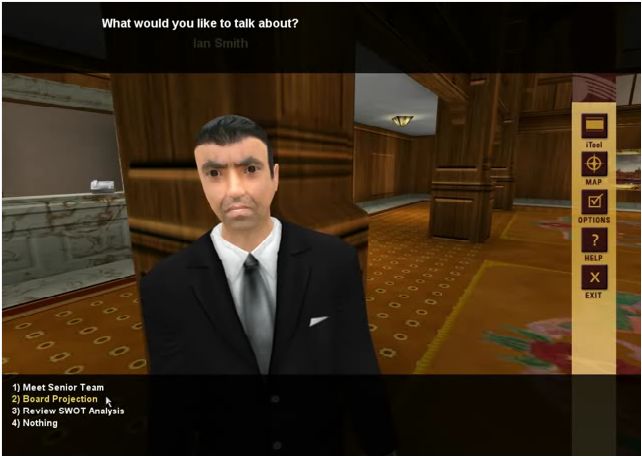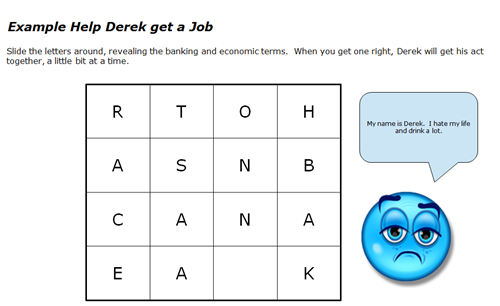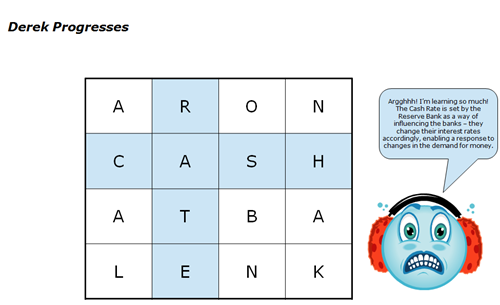Gaming is virtually ubiquitous, penetrating the lives of almost all of us in one form or another. One of the established symptoms of gaming is the acquisition of knowledge and skills, as researched extensively by many people, most notably James Paul Gee. His books are widely acknowledged as the foremost source of gaming in learning research. With that research well and truly squared away, our focus turns to how exactly to take advantage of this, still relatively new, communications channel.
Some facts and figures
The pervasiveness of gaming is understood by all of us affected by it, but there is still a sheen of prejudice expressed by those who see themselves as outside of the trend (and perhaps a little too mature for games). It is useful to have some information on hand to tackle these outsiders:
- Income generated from the video games industry now surpasses the film industry.
- The average age of a video game player in Australia is 30 (Interactive Australia Report, 2009, Nielson Research), and will rise to 42 by 2014 (the same as the average non-game player).
- 46% of video game players are female.
- Solitaire is the most successful video game in history; coming bundled with Windows has its advantages … not one avatar has been injured while playing solitaire.
- Casual gaming is the fastest growing genre within the video games industry, propelled by the Wii, iPhone, Android phones and internet distribution to the PlayStation and XBOX consoles.
- In its first year, the iPhone application store distributed 1.5 billion products (mostly games). For those that are counting, that’s almost one game for every four people on the planet. Not counting any other delivery channel (PlayStation, PC’s, etc).
What is a game?
In translating a concept such as this to the learning technology realm, it’s useful to understand exactly what the concept entails, so the essential elements can be maintained during any development / implementation.
According to Wikipedia: “A game is a structured activity, usually undertaken for enjoyment and sometimes used as an educational tool. Key components of games are goals, rules, challenge, and interaction.”
- The contest can be with other people, characters or the game world itself. What is essential is the sense of fun and challenge.
- In this context, ‘winning’ takes many forms, whether the player has topped another player’s score, bettered their own score or finally triumphed over the adversity of the game world / environment.
The implication of a ‘video’ game is the absence of a person with trusted authority to provide structured coaching or feedback. It is therefore essential that the game itself deliver on this requirement.
This definition is quite obviously incomplete: a game must be, above all else, fun. What some people find ‘fun’ is quite astounding; open an flight simulation program for evidence! So fun is really in the eye of the beholder, and tapping into that audience’s requirements for fun is essential to success.
In A Theory of Fun for Game Design, Raph Koster says that “exercising your brain is fun” as long as the activity is challenging. Games are about pattern matching, about special relationships, about exploring.
“the experience needs to be controlled by a set of commonsense rules … that limit player action, are explicit and unambiguous, are shared by all players, are fixed, are binding, and are repeatable.” (Rules of Play).
Good games contain:
- Moments of decision making
- Challenging goals
- Rewarding feedback
. . . all key ingredients for good learning. This interactive capability of presenting a goal or challenge and providing immediate feedback is essential for successful game-based learning.
Play is an activity, and the educational content of a game should be embodied and expressed in that activity, not presented on a platter in plain text. This is akin to the avoidance of exposition in novels. You should learn about the world through activities the protagonist undertakes, not through a blunt statement of fact. “John put his glass down on the deco coffee table, rattling its glass top.” Not, “In the room with John there was a deco style coffee table with a glass top.”
The Advantages of Games
“Games allow the learner to achieve at various levels, probe and reflect, fail without consequence, and, most importantly, practice continuously.” (from Gee’s ‘What Video Games Have to Teach Us about Learning and Literacy’)
Games have some advantages over other delivery channels.
- Can be fun for the majority of users, if designed well.
- Do not need to be complicated.
- Can promote repetition and therefore practice, without being tedious.
- Much information can be imbedded in a game through the creative use of rules, score keeping and the provision of rewards.
- Can integrate assessment, without the stress that assessment can often evoke.
- Attaining the knowledge required can be a pre-requisite of finishing the game. If the game is created with great skill, no explicit assessment may be necessary.
The concept of using games to educate and / or persuade an audience has been explored since the 1970’s, when Clark Abt released his book titled ‘Serious Games’. Although he discussed board and card games, the theories explored hold true for computer / video games today.
Challenges with Creating Games for Learning
“24 percent of e-learning developers reporting the usage of some type of game. Sixteen percent report that they have plans to use them in the next year. Games are tricky because of the cost of building them.” (Bersin)
Therefore it is essential that we:
- Keep it simple.
- Use experienced game developers – Individual contractors are completely fine for casual Flash games (see comments on casual games).
- Don’t be afraid to mix two development providers on one product; it’s very easy to plug a game into the middle of an online course, for example.
“Games are also perceived as being “undesirable” in corporate training because the term implies entertainment rather than training. Children learn with games – not adults … Games should be considered another form of ‘interactive simulation.’” (Bersin)
Therefore:
- Know your audience and frame appropriately.
- Provide fun and acceptability (e.g. do you need to call it a ‘game’?).
- Choose your reward structure carefully … bankers like money – even virtual money. They are less enthusiastic, perhaps, about smiley faces.
- Keep it professional:
- Quick to learn
- Quick to play
- Quick to reward
The current state
The corporate learning industry isn’t faring well in this space, unfortunately. The training game developer market is dominated by simulation developers with an L&D background and outdated impressions of the computer gaming concept:
- Ugly products (Thunderbirds are Go!).
- Irritating story lines acted out by D-Grade talent.
- ‘Virtual Worlds’ where you assume an identify (fully customisable) and wander around with other geeks, potentially conversing about a given business problem.
- Unnecessarily time consuming. In the virtual world scenario you could easily spend two hours just getting set up. Motivation killer.
The end product is not immersive and leaves the learner eager to get to the end of the material so they can just answer the questions already!
 Oh dear. Looks like someone already beat him up. |
The Rise and Rise of Casual Games
Simulations have been used very successfully by the US Military as both training and recruitment tools, but the cost of developing truly successful simulations is entirely prohibitive to most of the private sector. It is rare for a commercially released simulation to cost less than about $20m US Dollars to produce. Well produced ‘blockbuster’ titles, which frequently out-sell Hollywood movie revenues, can cost more than $50m US Dollars to produce.
Casual games are another story. Casual games are what you get on your mobile phone, iPhone, Nintendo Wii (primarily) and even Foxtel. Good casual games:
- Are very easy to learn. If more than one sentence of explanation is required, the game is unlikely to be successful.
- Are Challenging, but with a soft learning curve.
- Provide quick and (in more successful cases) meaningful rewards, e.g. where acquiring a certain volume of currency / points allows access to more material, abilities, etc.
- Can be picked up and put down during a five minute break, with satisfying results.
- Don’t waste your time with poor acting, complicated controls or convoluted story lines.
- Are designed to get mum and grandpa into the gaming market.
The gaming industry is adapting to the market opportunities which casual games expose, with extreme speed. The benefit to our profession is apparent: these products target a diverse audience with no assumed skill base.
A casual gaming approach can be used to embed knowledge or encourage problem-solving skills, likely with better results than can be achieved with over-developed simulation learning. Neither option will provide significant applicability to the real world in isolation.
Effectively Integrating Casual Games
The trick is to use the game appropriately (as with all learning technologies).
- Use as pre-work, as a replacement of traditional text-based delivery methods.
- Embed in an online course; if it’s good, people will talk, and new learners will be looking forward to that part of the course.
- As with all technologies that struggle with communicating real-life contextual implications, account for this requirement with other delivery channels, preferably involving first-hand accounts or conversations / activities.
An example
Be kind – I knocked this up quickly and will examine its shortcomings. Click on the pics for a bigger version.


Analysing the Derek game
The good:
- Simple – most people would have played a similar game at some point in their life, with the alphabet or numbers.
- There is some sense of progress, with the character’s knowledge / skills evolving in a parody of the learner’s progress.
- The humour may help to engage the audience.
- The game should be quick to complete, but still challenging for most people.
- The graphical prowess, which could only be achieved with state-of-the-art clip art.
The bad / ugly:
- The sense of progress is let down by the uselessness of the reward; while Derek has developed, the learner hasn’t gained anything useful. A better reward could be an increase in the number of tiles the learner was able to move during each turn of play.
- The humour may be misplaced, depending on the audience. Similarly, the game may be too simple for some.
- It’s actually impossible to complete the puzzle.
PuzzleQuest: An example of a successful casual game
Click on the pic for the full analysis.

What the player learns from using PuzzleQuest:
- The abilities of different types of characters and enemies.
- The value of different types of gems.
- The impact of different weapons and spells; their ability to influence opponents and gems.
- Strategies for manipulating gems into patterns that will give the most value.
- So, what if we think about the game a little differently…
Instead of Gems we have customers … instead of wizard’s we have bank tellers … instead of spells we have interest rates, ATM numbers and advertising spend … instead of attacking trolls we have competing banks … instead of health we have Net Profit after tax.
The result could, if designed well, teach the employee about the basic relationships between market forces and competitive success. Such a game would need to be supported by material which clarifies the context.
In summary
Hopefully this has given you some food for thought. Get out there and see what’s available. Here are some links to get you started:
Example games:
http://persuasivegames.com/games/game.aspx?game=coldstone
http://persuasivegames.com/games/game.aspx?game=debtski
http://persuasivegames.com/games/game.aspx?game=nyt_food
http://www.theproblemsite.com/games/word_grid.asp
http://www.stockmarketgame.biz/
Serious games at Michigan State University: http://seriousgames.msu.edu/
References:
http://www.gamasutra.com/view/feature/4090/persuasive_games_this_is_only_a_.php
http://works.bepress.com/jeff_brand/12/
Guide to creating games (for instructional designers): http://writersgateway.wordpress.com/2008/11/14/6-quick-steps-to-create-a-game-based-e-learning-course/
Learning objectives in games: http://elearningrandomwalk.blogspot.com/2006/08/why-most-off-shelf-commerical-games.html










Pingback: Modded Controllers And Other Gaming Mods | Max NDS